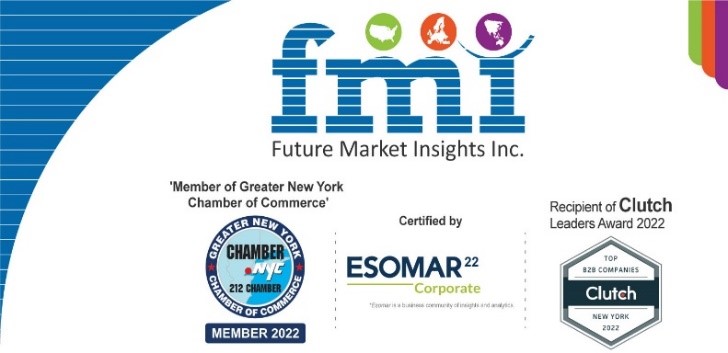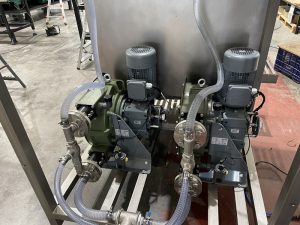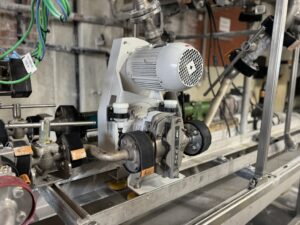The Peristaltic Pumps Market Size is Anticipated to Reach US$ 1.8 Billion in 2033

Image source: Future Market Insights
The peristaltic pumps market is experiencing significant growth and gaining traction across various industries due to its unique fluid-handling capabilities and versatile applications.
Peristaltic pumps, also known as tube pumps or hose pumps, offer precise and controlled fluid transfer, making them highly valued in sectors where accuracy and sterility are critical. The market is driven by factors such as:
- The pumps' ability to handle a wide range of fluids.
- Pumps' hygienic design for sensitive applications.
- Pumps' energy efficiency, which aligns with the growing emphasis on environmental sustainability.
Technological advancements and the integration of automation are shaping the future outlook of this dynamic market. As the demand for precise and reliable fluid transfer solutions continues to rise across multiple sectors, the peristaltic pumps market presents opportunities for manufacturers and end-users alike, propelling the market's evolution and development in the foreseeable future.
Consumption Analysis of Peristaltic Pumps (2018 to 2022) Vs Predicted Market Outlook (2023 to 2033)
2018 to 2022 Consumption Analysis
The peristaltic pumps market witnessed steady consumption growth of 5.5% across various industries during the period from 2018 to 2022.
The demand for these pumps was driven by their versatility, precise fluid handling capabilities, and suitability for sensitive applications in sectors such as pharmaceuticals, biotechnology, medical, and laboratory. Moreover, advancements in pump technology and increased adoption of automation further contributed to the market's expansion during this period.
Predicted Market Outlook (2023 to 2033)
The market's outlook remains optimistic, driven by various factors, including advancements in pump technology, expanding applications in research and development, and rising investments in automation integration.
The increasing focus on precision fluid handling in healthcare and medical sectors is anticipated to fuel further growth in demand for peristaltic pumps during the forecast period. The global push toward sustainability and the drive for energy-efficient solutions might also bolster the market's expansion, with peristaltic pumps being recognized for their low energy consumption and reduced environmental impact.
Latest Trends in Peristaltic Pumps Technology
Automation Integration: Peristaltic pumps are increasingly being integrated into automated systems and industrial processes. Automation allows for precise control, real-time monitoring, and remote operation, enhancing process efficiency and reducing the need for manual intervention.
Customization for Specific Applications: Manufacturers are offering customized peristaltic pump solutions to cater to the specific needs of different industries. This includes designing pumps with specialized materials for handling aggressive chemicals, higher flow rates for industrial applications, and optimized designs for pharmaceutical and biotechnology sectors.
Enhanced Tube Materials: Manufacturers are continuously innovating to develop improved tube materials that offer better chemical resistance, longer life spans, and reduced permeability. Enhanced tube materials increase pump reliability, reduce maintenance requirements, and address specific fluid compatibility challenges faced by various industries.
Compact and Portable Designs: A growing trend is the development of compact and portable peristaltic pumps, making them more versatile and suitable for field applications, point-of-care diagnostics, and portable medical devices.
Growth Barriers
Flow Rate Limitations: Peristaltic pumps may have limitations on high-flow applications compared to other types of pumps. Achieving very high flow rates may require larger pump sizes, which can be impractical for certain applications.
Cost Considerations: Peristaltic pumps can be relatively more expensive than some other types of pumps, especially for high-flow or high-pressure applications. The initial investment and ongoing maintenance costs can be a consideration for potential buyers.
Competitive Pressure: Peristaltic pumps face competition from other types of pumps, such as diaphragm pumps and gear pumps, which may offer advantages in specific scenarios. The presence of alternative technologies can create a challenging market landscape.
Opportunities
Bioprocessing and Food Industries: The bioprocessing industry, including fermentation and cell culture, relies on peristaltic pumps for gentle fluid handling, ensuring cell viability and product quality. Additionally, the food and beverage sector utilizes peristaltic pumps for hygienic fluid transfer and dosing in food processing applications.
Portable and Point-of-Care Devices: The trend towards portable medical devices and point-of-care diagnostics opens opportunities for compact and precise peristaltic pumps. These pumps find applications in portable medical equipment, wearable devices, and remote healthcare solutions.
Category-wise Insights of Peristaltic Pumps
Tube Pumps are Pumping as Front-Runners with a Growth Trajectory Of 3.5%
Tube pumps are a critical component in the peristaltic pumps market, enabling precise and pulsation-free fluid handling. Their flexible tubing ensures hygienic and versatile fluid compatibility, making them suitable for diverse applications.
Tube pumps offer ease of maintenance, reduced risk of contamination, and energy-efficient operation, making them essential for industries requiring accurate and sterile fluid transfer. Their significance lies in their ability to meet varied demands, from pharmaceuticals to industrial processes.
Regional Analysis of the Peristaltic Pumps Market
How does the Peristaltic Pumps Market in the United States Fare?
The peristaltic pumps market in the United States is expected to witness steady growth over the forecast period from 2023 to 2033. With a projected market size of US$ 322.2 million by the end of 2033 and a Compound Annual Growth Rate (CAGR) of 3.7% during this period, the market's trajectory indicates a moderate yet consistent expansion.
Factors contributing to this growth include advancements in pump technology, increasing applications in pharmaceuticals, medical, and industrial sectors, as well as the rising emphasis on precision fluid handling. The substantial forecasted market size reflects the continued demand for peristaltic pumps in the United States, making them significant components across diverse industries.
The United Kingdom Market Outlook
With a projected absolute dollar growth of US$ 21.3 million and a Compound Annual Growth Rate (CAGR) of 3.6%, the market's outlook indicates a moderate but consistent expansion.
This growth is attributed to factors such as advancements in pump technology, expanding applications in pharmaceuticals, medical, research, and industrial sectors, as well as the growing emphasis on precision fluid handling.
Peristaltic pumps play a vital role in various industries in the UK, catering to their need for accurate fluid transfer and versatility. The positive market outlook reaffirms the significance of peristaltic pumps in meeting the fluid-handling demands of the United Kingdom’s diverse sectors.
China is to Grow at Progressive Growth and Reach a Market Valuation of US$ 406.5 million by 2033.
China's role in the peristaltic pumps market is poised for significant growth, driven by its thriving economy and technological advancements. With a strong focus on precision fluid handling and diverse applications in pharmaceuticals, biotechnology, medical, and industrial sectors, the demand for peristaltic pumps is on the rise in China.
These pumps' versatility, hygienic design, and ability to handle sensitive materials align with the country's emphasis on quality control and sterile fluid transfer. The expanding healthcare sector, along with increasing investments in research and development, further contributes to the market's growth.
Competitive Landscape
The peristaltic pumps market boasts a highly competitive landscape, featuring a diverse range of players striving to meet the increasing demand for these pumps in various industries. Key players, including established manufacturers and emerging companies, focus on innovation and technological advancements to stay ahead. They offer a wide array of pumps with different specifications and applications to cater to diverse customer needs.
Providing reliable, energy-efficient, and cost-effective solutions, along with comprehensive after-sales services, is crucial for maintaining a competitive edge. Strategic partnerships and acquisitions are common strategies to expand product portfolios and geographical presence. Local manufacturers also play a significant role in regional markets, meeting specific customer requirements. As the market continues to grow, competition among players intensifies, driving innovation and further advancing peristaltic pump technology and applications.
Latest Developments
NETZSCH Pumps North America LLC joined the peristaltic market in April 2022 with the introduction of the PERIPRO Pump and extended its positive displacement pump capabilities. At varying pressures, the pump provides low and high flow rates.
DuPont introduced the new DuPont Liveo Pharma TPE Tubing in October 2021 at three industry events: CBioPC in Nanjing, China, INTERPHEX in New York, United States, and CPhI in Milan, Italy. Due to enhanced product awareness, such exhibits are projected to drive the industry.
Source: Future Market Insights






